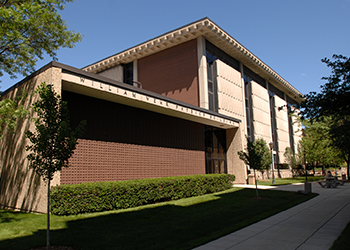Faculty Members Conducting Research
Students are encouraged to work with faculty mentors on research.
- Karen Andeen, Associate Professor, Ph.D. University of Wisconsin-Madison, works with the IceCube Neutrino Observatory to understand cosmic rays, the particles that are constantly bombarding us from outer space. What are they? Where do they come from? How do they get here? All of these questions are fundamental to a broader understanding of the universe. Dr. Andeen’s group is presently designing and testing new telescopes as an upgrade to the IceCube Neutrino Observatory, and is analyzing new data coming in from the South Pole. She is often accepting new research students in her lab—don’t hesitate to ask! Dr. Andeen is also interested in pushing physics education to the next level, and in helping students find their best fit in the many career options available to physics undergraduates, from science policy to fundamental physics: stop by anytime to explore your ideas!
- Brian Bennett, Professor, D. Phil. (Sussex), is a biophysicist who uses a magnetic resonance method, electron paramagnetic resonance (EPR), to study the effects of cancer, metabolic diseases, and therapies on the energy-producing mitochondrial respiratory chain, by studying intact biopsy tissue at extremely low temperatures (10 K). Dr. Bennett also studies the mechanisms of metalloproteins with applications in "green chemistry", pharmaceutical synthesis, and reclamation of pesticide-contaminated land. Dr. Bennett regularly accepts students for research in his lab from programs that include Biophysics, Physics, Chemistry, Biological Sciences, and Biomedical Sciences.
- Sarah Erickson-Bhatt, Assistant Professor, Ph.D. Florida International University (Miami), is a biophysicist developing imaging systems and computational tools to study cancer formation, progression and metastasis leading toward future clinical interventions. She is devising a custom-built confocal imaging system to study cancer histology slides and ultimately live cells to assess cancer behavior. In parallel to this imaging work, she is working on computational tools to simulate light propagation and cancer behavior in human tissues.
- Andrew Kunz, Professor, Ph.D. University of Minnesota, simulates magnetic materials in order to better understand the dynamic response of such systems. The simulation results are used to create physical models for magnetoresistive and other spintronic devices. He is also interested in improving physics education.
- Michael Politano, Associate Professor, Ph.D. University of Illinois, models populations of interacting binary stars with emphasis on model populations of cataclysmic variable stars, such as novae. He is interested in physics education and teacher preparation.
- Jax Sanders, Assistant Professor, Ph.D. University of Michigan, designs subsystems for gravitational wave interferometers and works to design new detectors to expand the scope of the new field of gravitational wave astronomy. (further details coming soon!)
- Christopher Stockdale, Associate Professor, Ph.D. Oklahoma, is actively engaged in a multi-wavelength study of core collapse supernovae. He observes the radio emission from these events and their surroundings using a variety of instruments, but primarily the Very Large Array in Socorro, New Mexico.
- Tim Tharp, Assistant Professor, Ph.D. University of Wisconsin-Madison, is an experimental plasma physicist. He has worked on topics including fusion energy, solar flare physics, and antimatter physics. He is currently working with the ALPHA experiment at CERN to manufacture and study antihydrogen. At Marquette, Dr. Tharp has worked with students to build antimatter plasma diagnostics that are used to manipulate and study antimatter in the laboratory.


